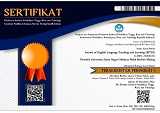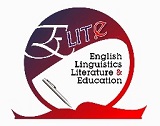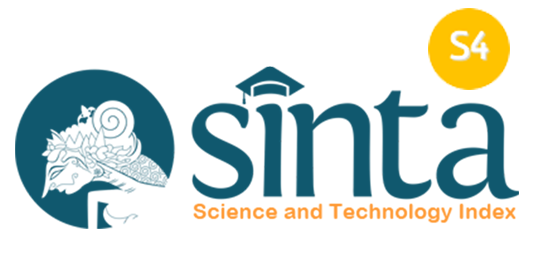Multimodal Learning Material in An English-Speaking Class in Kampung Baluwarti
Abstract
This study mainly concerned about the use of Multimodal learning material in enhancing students’ English-speaking skill. The study was carried out in Kampung Baluwarti Surakarta as the researcher was one of the tutors involved in Community service team of ABA St. Pignatelli Surakarta during January to March 2022. The main objective of this study was to investigate the implementation of multimodal learning material used in English speaking class of Kampung Baluwarti tourism community. Furthermore, their perceptions towards the use of the learning material were depicted as well. Qualitative research with narrative design was used in this study. The researcher collected the data through a variety of data collection got from in-depth interviews with the students, observation, and documents. It was discovered that multimodal learning material could be presented in various mode such as sound, picture, motion and written text to accommodate students’ learning. It helped students to be more active in practicing the target language. Students’ involvement was seen more during the lesson. Moreover, students seemed to be excited and comfortable during the class. In other words, multimodal learning material applied in the teaching learning process makes a difference in students’ speaking skill achievement.
Keywords
Full Text:
PDFReferences
Byrne, D. (1996). Teaching oral English (New ed., 11. impr). Longman.
Creswell, J. W. (2014). Research design: Qualitative, quantitative, and mixed methods approaches (4th ed). SAGE Publications.
Daniels, H. (2001). Vygotsky and pedagogy. RoutledgeFalmer.
Djamdjuri, D. S., Suseno, M., Tajuddin, S., Lustyantie, N., & Chaeruman, U. A. (2021). Multimodal Approach in Online EFL Class Using Islamic Learning Materials: Students’ Perspective. International Journal of Language Education, 5(4), 337. https://doi.org/10.26858/ijole.v5i4.22495
Harmer, J. (2006). The practice of English language teaching (3. ed., completely rev. and updated, 8. impr). Longman.
Ikasari, B., Drajati, N. A., & Sumardi, S. (2019). The use of multi-modal texts in an English classroom of hard-of- hearing learners. Pedagogy : Journal of English Language Teaching, 7(2), 95. https://doi.org/10.32332/pedagogy.v7i2.1661
Kress, G. R., & Van Leeuwen, T. (2001). Multimodal discourse: The modes and media of contemporary communication. Arnold ; Oxford University Press.
Maguire, L. L. (2005). Literature review--faculty participation in online distance education: Barriers and motivators. Online Journal of Distance Learning Administration, 8(1).
Moody, A. (2010). Using electronic books in the classroom to enhance emergent literacy skills in young children’. Journal of Literacy and Technology, 11(4), 22–52.
Nunan, D. (2003). Practical English language teaching. McGraw-Hill. https://archive.org/details/practicalenglish0000nuna
Richards, J. C., & Renandya, W. A. (Eds.). (2013). Methodology in language teaching: An anthology of current practice (1st publ., 17. print). Cambridge Univ. Press.
Tomlinson, B. (Ed.). (2013). Developing materials for language teaching (Second Edition). Bloomsbury.
Wu, S. (2020). Multimodal Approach to Teaching English in Higher Education. Journal of Contemporary Educational Research, 4(7). https://doi.org/10.26689/jcer.v4i7.1374
DOI: https://doi.org/10.18860/jetle.v3i2.15878
Refbacks
- There are currently no refbacks.
Jalan Gajayana 50 Malang 65144, Jawa Timur, Indonesia

This work is licensed under a Creative Commons Attribution-ShareAlike 4.0 International License.
Indexed by





